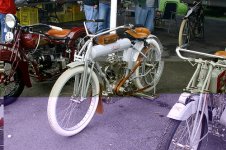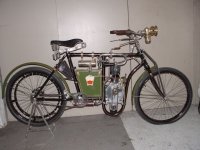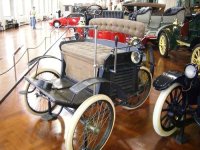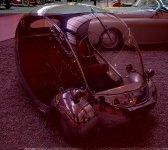You are using an out of date browser. It may not display this or other websites correctly.
You should upgrade or use an alternative browser.
You should upgrade or use an alternative browser.
Horses of Iron
- Thread starter Lock
- Start date
evmotorcycle.org
10 mW
- Joined
- Feb 18, 2008
- Messages
- 32
Beautifully crafted machines! I must admit that I am finding this whole Steampunk thing VERY interesting. Perhaps a Steampunk styled EVMOTORCYCLE is on the cards!! >
evmotorcycle.org
10 mW
- Joined
- Feb 18, 2008
- Messages
- 32
Then there will have to be a new style made, where function IS the design. Motor, controller, fuses, bus bars, cables all making up the form of the bike with possible elements of Steam Punk influencing the overall look.
Lock
100 MW
Ya, OK, maybe steampunk was the wrong word <smile>... "Retro" maybe...Maybe I lack the imagination for "Steam Punk"... But most of what I've seen is fluff or window dressing on a functional device...
Well, can't agree here unless you agree that esthetics can be incorporated without degrading "things"... and it's "esthetics" where we shine as humans (well, *some* of us shine <wink>)The bikes pictured are classic styling for the turn of the last century, and functional... It's when you start to take a useful design and degrade it simply for esthetics that I have to shake my head...
It's like the diff. between a new building designed by engineers and contractors without input from architects?
Found another Flickr photostream that's got "retro" bits:
http://www.flickr.com/photos/metric/sets/72157594445112476/show/with/336680669/
Stuff like:

tks
LOk
Lock
100 MW
Miles said:Lots of good pics here:
http://www.motorarchive.com/
http://www.users.globalnet.co.uk/~pattle/nacc/arcindex.htm
http://www.autocycles.co.uk/
TKS Miles. Wonderful stuff eg
http://www.users.globalnet.co.uk/~pattle/nacc/arc0220.htm
"The Cyc-Auto has an important place in British motor cycle history because it was the original autocycle. The road taxation system in Britain after the Great War did not encourage the production of really lightweight machines like those produced on the Continent. It was only after Philip Snowden's Budget of 1931, which introduced a tax concession for machines under 100cc, that it became worthwhile to produce a motorised bicycle. Mr Wallington Butt's Cyc-Auto was the first on the scene."
tks
LcK
Lock
100 MW
Lock
100 MW
Lock
100 MW
Lock
100 MW
Lock
100 MW
1937 Airomobile
Following the closure of the Franklin Automobile Company in 1934, former Franklin engineers Carl Doman and Edward Marks organized their own firm to develop a new air-cooled engine. Paul Lewis of Denver, Colorado conceived the idea for this futuristic car in the early 1930's and in 1936, contracted with Doman and Marks to build a prototype. Working with an aerodynamically styled model created by John Tjaarda, designer of the Lincoln Zephyr, construncted began on the unusual three-wheeled front-drive Airomobile and it was pronounced road-ready in April, 1937. THe Airomobile prototype dispalyed here was driven more than 45,000 miles throughout the United States in a promotional effort to raise production capital. While the Airomobile proved itself a technical success by performing credibly at speeds of up to 80 mph and averaging 43.6 miles per gallon of fuel. financial backing was not forthcoming.
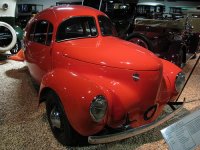
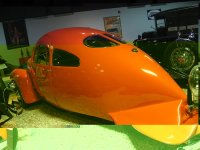
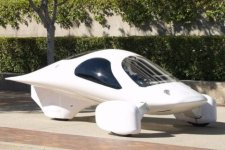
Following the closure of the Franklin Automobile Company in 1934, former Franklin engineers Carl Doman and Edward Marks organized their own firm to develop a new air-cooled engine. Paul Lewis of Denver, Colorado conceived the idea for this futuristic car in the early 1930's and in 1936, contracted with Doman and Marks to build a prototype. Working with an aerodynamically styled model created by John Tjaarda, designer of the Lincoln Zephyr, construncted began on the unusual three-wheeled front-drive Airomobile and it was pronounced road-ready in April, 1937. THe Airomobile prototype dispalyed here was driven more than 45,000 miles throughout the United States in a promotional effort to raise production capital. While the Airomobile proved itself a technical success by performing credibly at speeds of up to 80 mph and averaging 43.6 miles per gallon of fuel. financial backing was not forthcoming.



Lock
100 MW
Lock
100 MW
Lock
100 MW
That's hot. I'd forgotten Messerschmidt made some Tigers w/4-wheels...
View attachment Messerschmidt.jpg
View attachment Messerschmidt.jpg
Lock
100 MW
Not kiddin' about the hotness eh?
eBay second-hand Buy-Now Price only US $799.99:
http://tinyurl.com/Messerschmitt
kidding. Thats just for an old toy miniature copy
The originals were powered near 20kW w/kerb weights 660-800+lbs. Guessing a Lithium pack would give a Tiger conversion huge range.
eBay second-hand Buy-Now Price only US $799.99:
http://tinyurl.com/Messerschmitt
kidding. Thats just for an old toy miniature copy
The originals were powered near 20kW w/kerb weights 660-800+lbs. Guessing a Lithium pack would give a Tiger conversion huge range.
Lock
100 MW
Model of how some early electrics were built as "solenoid engines" after steam designs:
View attachment Solenoid.jpg
from YouTube here:
[youtube]9a1rgkcm0cA[/youtube]
Model of the electric "motor" built by Charles Grafton Page in 1838!:
View attachment Page.jpg
mascobe on youtube models some tiny (brass?whatever) solenoid motors that could serve in steampunk costume, weapons AND VEHICLES no problem
http://ca.youtube.com/profile?user=mascobe&view=videos
These solenoids aren't especially efficient but the "reciprocating" sounds some of `em make is pretty fun too.
...just a note to any steampunks or wannabes that might be alongside ES

tks
loK
View attachment Solenoid.jpg
from YouTube here:
[youtube]9a1rgkcm0cA[/youtube]
Model of the electric "motor" built by Charles Grafton Page in 1838!:
View attachment Page.jpg
mascobe on youtube models some tiny (brass?whatever) solenoid motors that could serve in steampunk costume, weapons AND VEHICLES no problem
http://ca.youtube.com/profile?user=mascobe&view=videos
These solenoids aren't especially efficient but the "reciprocating" sounds some of `em make is pretty fun too.
...just a note to any steampunks or wannabes that might be alongside ES
tks
loK
Lock
100 MW
Lock
100 MW

Many EV ppl on ES are real gearheads. I mean that only in the nicest way
Steampunks drip w/costume made using gears

View attachment 2

...and seems ya really need a set of googles... here's goggles with gears
View attachment Goggles.jpg
Lock
100 MW
I know this EV has come up on ES elsewhere but I throw it in here just for completeness, and cause these are some of the better pics I've seen:
http://steampunkworkshop.com/steampunk-motorbike.shtml
View attachment Whirlygig Emoto.jpg
http://steampunkworkshop.com/steampunk-motorbike.shtml
View attachment Whirlygig Emoto.jpg
Lock
100 MW
thomas
10 W
looks like something from a Jules Verne book 
evmotorcycle.org
10 mW
- Joined
- Feb 18, 2008
- Messages
- 32
They are great! Gotta love the Whirlygig! Oh… and the ladies! >
michaelplogue
10 kW
I love the Messerschmidt KR200's - three wheeled so it can be classified as a motorcycle, yet enclosed with a passenger seat. I'm seriously thinking that this may be my next e-project. I found a company in England that makes complete reproduction kits so you wouldn't need to find an original for modification.
By using Headway type cells, I've figured that I could get at least 9600 w/h worth of batteries (48V 200AH or 72V 100AH) in the main cabin while keeping the rear seat. Without the back seat that could be easily doubled.

By using Headway type cells, I've figured that I could get at least 9600 w/h worth of batteries (48V 200AH or 72V 100AH) in the main cabin while keeping the rear seat. Without the back seat that could be easily doubled.

Lock
100 MW
Sweet.michaelplogue said:I love the Messerschmidt KR200's
Not steam but as I understand it totally steampunk. Ya might have to install port-starboard kerosene running lights and a couple of bit of brass but as "Captain Nemos personal Land Yacht" (submersible too of course) you would only need some costume. Some steampunk are pirate and some air pilots etc so the Messerschmidts are totally .... well, I suspect a good fit <grin>
What evmotorcycle.org said "Oh… and the ladies! >
Point is, women are totally into the steampunk scene. Much more than say... the EV scene? <hehe>
Ya know, if you respect a woman that knows how to handle tools and pitchs in

Similar threads
- Replies
- 26
- Views
- 8,992
- Replies
- 6
- Views
- 4,375
- Replies
- 17
- Views
- 2,993
- Replies
- 143
- Views
- 36,263


